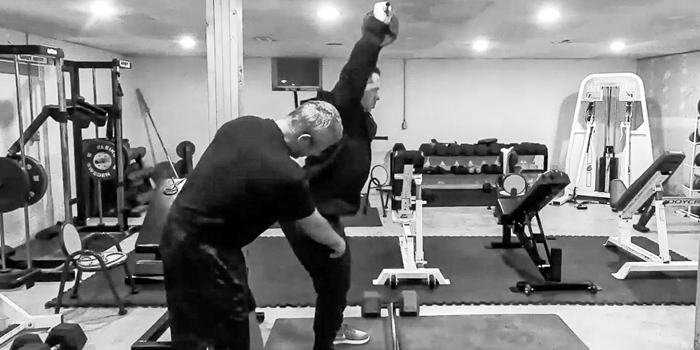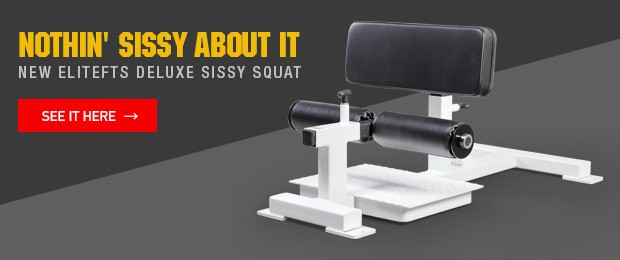
Coauthored by Scott H. Mendelson and Eric Serrano, MD
Yet again Dr. Eric Serrano develops a groundbreaking exercise that is very simple to learn and execute. What good is a new exercise if it is done poorly? For this exercise pay special attention to the use of the stationary post, which is used as a point of reference for the glutes to touch while maintaining knee flexion of five to 10 degrees. Performing the posterior chain overhead deadlift properly with these simple tips creates excellent engagement of the hamstrings, glutes, upper back muscles, and more. Leave your ego at the door and use the simple PVC pipe as instructed, which may feel like a ton while the shoulders are activated in the proper position.
MORE: Band Tension for the Pull-Up and Push-Up
The posterior chain overhead deadlift is highly beneficial for athletes seeking to improve their strength as well as coordination of their entire posterior chain. Dr. Eric Serrano created this unique exercise and series of specialized executions to reduce joint stress while engaging the hamstrings, glutes, core, lower back, and posterior shoulder muscles with functional training strategies. With it you can:
- Dominate competitions
- Improve posterior chain coordination
- Fix weak links to reduce the risk of injury
- Prepare the muscles, nervous system, and joints for intense training sessions
Fixing Weak Links
Athletes are at a high risk of injury or poor performance due to hamstring weaknesses that are most appropriately fixed with strategic exercises involving the entire posterior chain. Athletic competition and daily tasks rarely isolate individual muscles and require an entire chain of muscles to work together correctly for the best outcomes. Powerlifters, bodybuilders, CrossFit athletes, and recreational trainees can reduce the risk of many injuries and improve competition performance by addressing common weaknesses with proper execution of the posterior chain overhead deadlift.
Getting Your Training Sessions Off to a Great Start
The posterior chain overhead deadlift should be done at the start of a workout following a 10-minute generalized warm-up to break a sweat and to prepare the body for training. Adding new movements to the beginning of a training session ensures better execution due to the “freshness” of the nervous system at that time and lack of fatigue accumulated during the training session.
Reducing the Risk of Injury and Improving Competition Performance
During athletic competition, the body must coordinate many complex structures at one time. A weak link is often the limiting factor for performance and the most likely location for injury. The posterior chain overhead deadlift trains the entire posterior chain in one motion to support better coordination while minimizing weaknesses. The same reasoning can be applied to improved performance, as fixing weak links often leads to elevated running speed, jumping capabilities, changing of direction efficiency, decelerating abilities, and more.
Firing Up Muscles and the Nervous System Before Compound Movements
Dr. Serrano developed this exercise and unique executions to support fantastic training sessions. Correct execution of the posterior chain overhead deadlift will prepare the joints, muscles, and nervous system for challenging squats, deadlifts, Olympic lifts, and other complex movements. Maximizing activation qualities while minimizing fatigue is achieved by performing two to three work sets of the posterior chain overhead deadlift.
Proper Rep Timing to Improve Muscle Engagement
We suggest starting with sets of no more than four reps to support proper form and the speed of repetition. From the top position with the arms extended take four seconds to get to a parallel torso position with the glutes touching the post as a point of reference for proper posterior chain engagement. Pause for four seconds in the bottom position while maintaining tension and the proper bar status. Due to the difficulty of the movement most trainees will want to let the bar slump closer to the floor, which reduces tension on the posterior shoulder muscles and reduces the benefits of the exercise. Take two seconds to return to the top position in a controlled manner. A knee bend of five to 10 degrees should remain the same throughout the entire set.
Low Weight Loads to Create BIG Benefits
The four-second pause at the bottom of the movement dramatically increases the intensity of the hamstring, glute, core, and upper back muscle contractions, even with a very low weight load. This is due to the nature of the movement, created by Dr. Eric Serrano to improve patient performance and prevent injury. A novice can execute the movement without any additional weight load by simply holding an empty PVC pipe. Gradually increase the weight load from five to 10 pounds as the proper form is mastered. Have a friend video your execution with a cell phone camera so you can evaluate the execution progress. A PVC pipe is a great starting point, but adding weight load will require a metal bar designed to withstand the pressures of the external load without breaking. Anyone with an injury history or illness requires expert supervision and will need to consult their doctor before making changes to their exercise program.
Loading Position Modifications
Dr. Serrano increases the hamstring, glute, lower back, and core emphasis by increasing the load with a lower bar position, even with the nose at the start of the movement instead of over the top of the head. An athlete who has a strategic weakness in-season, for example, may have to use specific modifications to improve performance or to return more quickly from injury.
Grip Width Adjustments
Rhomboid muscle recruitment can be increased with a grip three inches wider than shoulder width when gripping the bar. We encourage athletes to vary movements strategically every four to six weeks to keep stimuli very fresh. Adjusting the position and grip width of the bar is one way to introduce fresh stimuli and strategic challenges regularly.
Altering Foot Position to Impact Hamstring Recruitment
Dr. Serrano uses a slight internal or external rotation of the feet to fix weak links identified during his extensive professional athlete evaluations. Internal rotation will increase the stimulation of the interior portion of the hamstrings. A slight external rotation of the feet does not feel as natural and does not require weight load to stretch the biceps femoris.
Please email scott@infinityfitness.com with any detailed questions you may have. Stay tuned for more specialized lower body exercise videos designed for athletes to dominate competitions.
Disclaimer
Exercise, nutrition, and food supplements may affect you differently from another person depending upon your choices, combinations, intensity, timing, general health, and genetics, among other factors. Scott Mendelson cannot offer specific advice on your fitness program nor guarantee your results, as we intend merely to get you thinking about your fitness, nutrition, food supplement, and bodybuilding choices. We recommend that you discuss your exercise, nutrition, and food supplement choices with your physician, trainer, employer, organization, governing bodies, and dietitian. We make no representation or warranty as to the accuracy of the information provided; in particular, and without limitation of the foregoing, any express or implied warranty of fitness for a particular purpose, merchantability, warranties arising by custom or usage and warranties by operation of law are expressly disclaimed.
Scott H. Mendelson is director of www.InfinityFitness.com and is a highly regarded performance nutrition and training specialist. In addition to designing customized programs for his celebrity, weekend warrior, and executive clients, Scott works daily with professional athletes from the NFL, NHL, MLB, NBA, and NCAA. Scott has built an excellent reputation providing effective supplements, cutting-edge information, and unmatched service to thousands of clients worldwide since 1999. He also serves as Special Assistant to Dr. Eric Serrano and helps with the design of training, nutrition, and supplementation trials to confirm the effectiveness of protocols and expand his expertise.
Dr. Eric Serrano, MD, is the ace sought out by elite athletes and business professionals around the world for help with the most difficult of problems. Dr. Serrano spends the majority of his time promoting the success of his family practice patients in Pickerington, a suburb of Columbus, Ohio. Amongst the thousands of patients are elite athletes from around the globe who will travel to the ends of the earth to consult with Dr. Serrano.










1 Comment